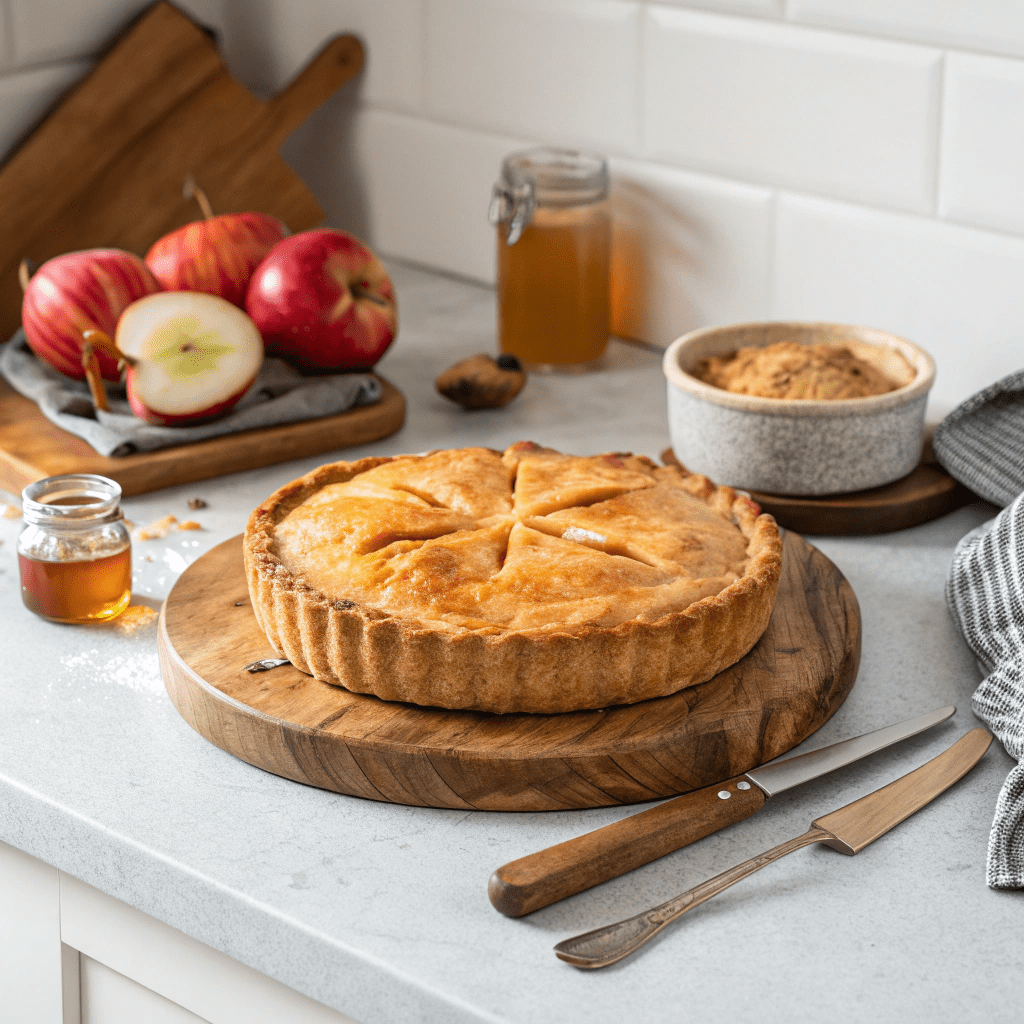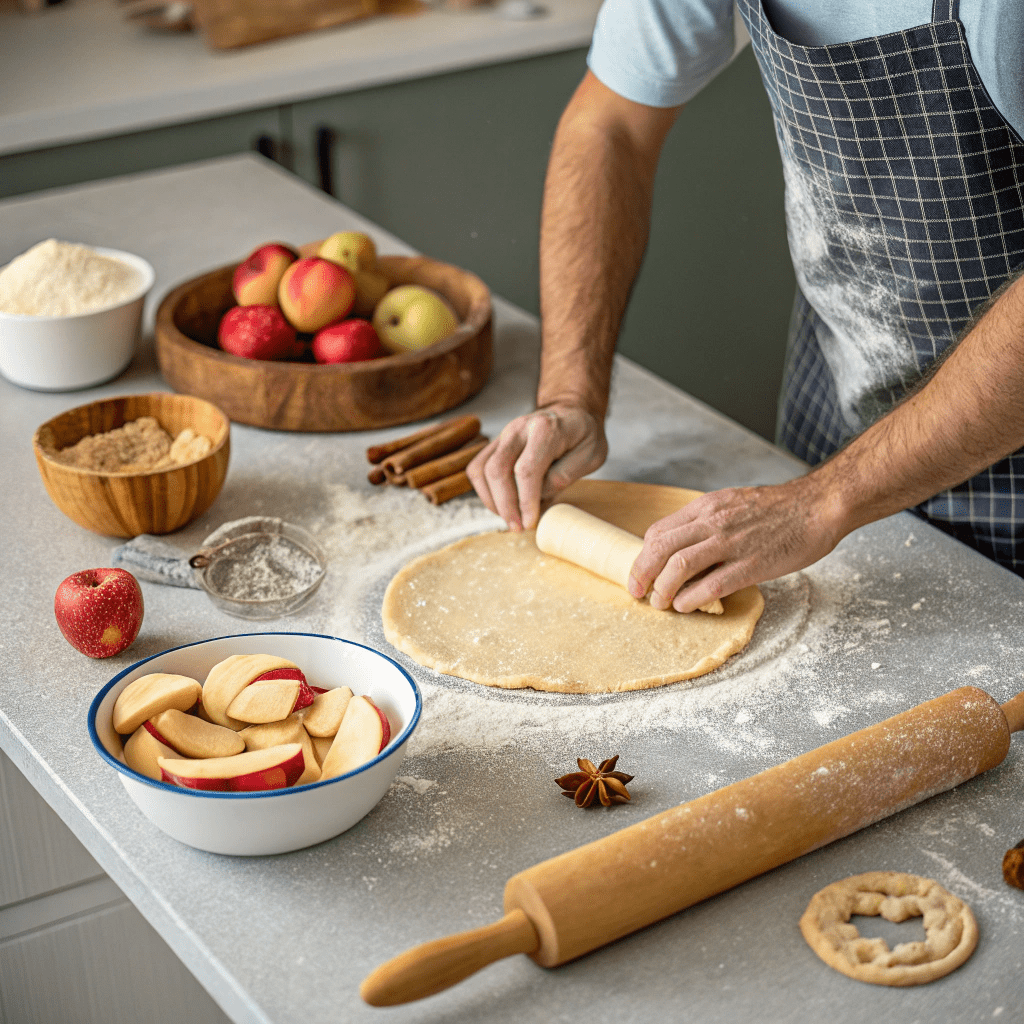
Spanish apple pie, or Empanada de Manzana, is a delightful pastry that perfectly balances the sweetness of apples with the richness of buttery crusts and aromatic spices. This traditional dessert holds a cherished place in Spanish cuisine, often enjoyed at celebrations, family gatherings, or simply as a comforting treat with a cup of coffee or tea. Its rustic charm and versatility make it a beloved dish across Spain, with regional variations that showcase the culinary diversity of the country.
The Empanada de Manzana isn’t just food—it’s a story on a plate. Passed down through generations, it reflects Spain’s rich cultural tapestry, combining Moorish influences with local ingredients. Whether you’re a baking novice or a seasoned chef, this guide will walk you through the history, ingredients, and step-by-step recipe to bring a slice of Spain to your table.
History of Empanada de Manzana
Origins of the Dish
The concept of the empanada originated from the word “empanar,” which means “to wrap in bread” in Spanish. While savory empanadas are more commonly associated with Spain’s culinary history, the sweet variety evolved as an adaptation for festive occasions. Empanada de Manzana likely emerged during the Moorish occupation of Spain, which introduced sugar, cinnamon, and other sweet spices into the local cuisine.
Evolution Over Time
Initially made with simple ingredients like apples, flour, and honey, the dessert transformed over the centuries as trade brought new influences. The inclusion of butter, refined sugar, and baking techniques refined the dish into the flaky, flavorful pastry we know today.
Regional Variations Within Spain
In Galicia, empanadas are often larger and filled with regional apples like Pippin or Reineta, combined with local honey. In Catalonia, a hint of lemon zest or anise seeds might be added for extra aroma. Each region infuses its unique touch, making the dish a versatile canvas for creativity.
For more inspiration on Spanish cuisine, you can explore Spanish Seafood Paella Recipe, another iconic dish that highlights Spain’s culinary artistry.
Difference Between Spanish Apple Pie and American Apple Pie
Comparison of Ingredients
Spanish apple pie tends to use fewer ingredients than its American counterpart, focusing on the natural sweetness of the apples. While American recipes often include brown sugar, nutmeg, and vanilla extract, the Spanish version leans on cinnamon, lemon zest, and sometimes honey or almonds to enhance the flavor.
Variations in Preparation Methods
American apple pies are typically baked in a deep dish with a lattice or full crust covering the filling. On the other hand, Empanada de Manzana is a flatter, enclosed pastry. The dough is rolled thinner, giving it a delicate crispness.
Distinctive Taste and Texture Differences
While both pies celebrate the apple’s natural flavor, Empanada de Manzana’s texture is lighter and more crumbly. The pastry plays a leading role, with a subtle sweetness and a satisfying crunch. Meanwhile, American apple pies are more filling-forward, emphasizing a gooey, spiced center.
Key Ingredients
Types of Apples Used
The apples are the star of this dessert. Traditional recipes often call for tart varieties like Reineta, Granny Smith, or Pippin apples, which hold their shape and offer a pleasant contrast to the sweetened pastry. These apples don’t become overly mushy during baking, ensuring a perfect balance of texture and flavor.
Pastry Components
The dough for Empanada de Manzana is made with simple ingredients like all-purpose flour, butter, a pinch of salt, and water. Some recipes might include a bit of sugar or eggs for added richness. The key is achieving a texture that’s flaky yet sturdy enough to hold the filling.
Common Spices and Flavorings
Cinnamon is the reigning spice in Empanada de Manzana, lending a warm and aromatic touch. Lemon zest is another key flavoring, offering a bright, citrusy note that cuts through the richness of the pastry. In some regions, you might find the addition of anise seeds, vanilla, or even a drizzle of honey for a nuanced flavor profile.
If you’re a fan of Mediterranean-inspired flavors, check out Salad Dressing for Mediterranean Salad for a delightful accompaniment to your meals.
Step-by-Step Recipe

Making Empanada de Manzana at home is easier than you think! With a few basic ingredients and some patience, you can create a dessert that’s as delicious as it is authentic. Let’s get started.
Detailed List of Ingredients with Measurements
For the dough:
- 2 ½ cups all-purpose flour
- 1 cup unsalted butter, chilled and cubed
- ½ teaspoon salt
- 2-3 tablespoons granulated sugar (optional)
- 6-8 tablespoons cold water
For the filling:
- 4 medium apples (Granny Smith or Reineta), peeled, cored, and thinly sliced
- ½ cup granulated sugar (adjust to taste)
- 1 teaspoon ground cinnamon
- 1 teaspoon lemon zest
- 1 tablespoon lemon juice
- 1 tablespoon all-purpose flour (to thicken the filling)
Instructions for Preparing the Dough
- Mix the dry ingredients: In a large bowl, combine the flour, salt, and sugar (if using).
- Incorporate the butter: Add the chilled, cubed butter to the flour mixture. Use your fingertips or a pastry cutter to work the butter into the flour until the mixture resembles coarse crumbs.
- Add water: Gradually add cold water, one tablespoon at a time, mixing gently until the dough comes together. Avoid overworking the dough.
- Chill the dough: Form the dough into a disc, wrap it in plastic wrap, and refrigerate for at least 30 minutes.
Guide to Making the Apple Filling
- Prepare the apples: Peel, core, and slice the apples thinly to ensure even cooking.
- Combine the ingredients: In a bowl, mix the apples with sugar, cinnamon, lemon zest, lemon juice, and flour. Toss until evenly coated.
- Let it rest: Allow the mixture to sit for 10-15 minutes. This step lets the flavors meld and the apples release some of their juices.
Assembly and Baking Directions
- Preheat the oven: Set it to 375°F (190°C). Line a baking sheet with parchment paper.
- Roll out the dough: Divide the chilled dough in half. Roll out one portion on a floured surface to about ¼ inch thick. Place it on the baking sheet.
- Add the filling: Spread the apple mixture evenly over the dough, leaving a 1-inch border.
- Top with the second layer: Roll out the remaining dough and place it over the apples. Seal the edges by pressing them together with a fork.
- Vent and bake: Cut small slits on the top crust to allow steam to escape. Bake for 35-40 minutes or until golden brown.
- Cool and serve: Let the empanada cool slightly before slicing.
Tips for the Perfect Empanada de Manzana
Selecting the Best Apples
Choose firm, tart apples that hold their shape during baking. Popular choices include Granny Smith and Reineta apples. If you prefer a sweeter profile, try mixing in Fuji or Honeycrisp apples.
Achieving the Ideal Pastry Texture
Keep your butter cold, and handle the dough as little as possible to ensure a flaky texture. Overmixing can make the pastry tough.
Common Mistakes to Avoid
- Overfilling: Too much filling can cause the empanada to leak.
- Skipping the vents: Failing to cut vents in the top crust can lead to a soggy pastry.
- Using overly ripe apples: These can turn mushy and release excess moisture.
Serving Suggestions

Ideal Accompaniments
Serve your Empanada de Manzana warm with a scoop of vanilla ice cream or a dollop of whipped cream. For a traditional Spanish touch, drizzle a bit of honey over the slices.
Appropriate Serving Temperatures
This dessert is best enjoyed slightly warm or at room temperature. Avoid serving it straight out of the oven, as the filling needs time to set.
Presentation Ideas
Sprinkle powdered sugar over the top before serving for a simple, elegant look. If you’re feeling creative, use a lattice design for the top crust or shape the dough into decorative edges.
Variations of the Recipe
Incorporating Additional Fruits
Add diversity to the filling by including fruits like pears, peaches, or berries. These pair beautifully with apples and can add a pop of color and flavor.
For a unique Mediterranean twist, try ideas inspired by a Tunisian Brik: Crispy Pastry Delight—it showcases how pastries can adapt to regional flavors.
Alternative Spices and Flavorings
Experiment with spices like cardamom, nutmeg, or ginger for a unique twist. A splash of vanilla extract or almond essence can also enhance the flavor.
Adapting the Recipe for Dietary Restrictions
- Gluten-Free Option: Replace all-purpose flour with a gluten-free flour blend designed for baking. You may need to adjust the water content for the dough.
- Vegan Adaptation: Use plant-based butter or coconut oil in the pastry and substitute honey with agave syrup if used.
- Low-Sugar Version: Reduce the sugar in the filling and rely on the natural sweetness of the apples. Alternatively, use a sugar substitute like erythritol or stevia.
For more vegetarian and vegan-friendly recipes, you might enjoy Chickpea Flour Pancakes, a savory dish that complements diverse dietary needs.
Health Considerations
Nutritional Information
Empanada de Manzana is a delightful treat, but it’s essential to understand its nutritional breakdown, especially if you’re keeping track of your diet. On average, one slice of this dessert contains:
- Calories: 250-300 (depending on sugar and butter content)
- Fat: 12-15 grams
- Carbohydrates: 35-40 grams
- Sugar: 15-20 grams
- Protein: 3-4 grams
These values can vary based on portion size and ingredient substitutions, but they provide a general idea.
Tips for Reducing Sugar and Fat Content
Want a lighter version of Empanada de Manzana? Here are some tips:
- Use less sugar: The natural sweetness of the apples can often suffice. Reduce sugar in the filling or opt for a sugar substitute like erythritol or monk fruit sweetener.
- Cut back on butter: You can replace half the butter in the dough with Greek yogurt for a lighter alternative without compromising texture.
- Incorporate whole grains: Use whole wheat pastry flour instead of refined flour to increase fiber and make the dish more filling.
Gluten-Free and Vegan Adaptations
Gluten-Free Option
Making a gluten-free Empanada de Manzana is easier than ever with the availability of gluten-free flour blends. Here’s how to adapt the recipe:
- Flour Substitute: Use a gluten-free all-purpose flour mix that contains xanthan gum or guar gum to provide elasticity.
- Handling Tips: Gluten-free doughs can be more fragile, so handle the dough gently and chill it thoroughly to make rolling and shaping easier.
- Baking Adjustments: Keep an eye on the baking time, as gluten-free crusts may brown faster. Cover the edges with foil if needed.
Vegan Adaptation
For a plant-based version, simple swaps can make the dish vegan-friendly without losing its signature flavors:
- Butter Replacement: Use a vegan butter substitute or chilled coconut oil in the pastry.
- Sugar Substitution: Ensure the sugar is vegan (some sugars are processed with bone char). Organic sugar is a safe choice.
- Egg Wash Alternative: Skip the egg wash and use a mixture of plant-based milk and maple syrup to achieve a golden-brown crust.
Both adaptations make the recipe more inclusive, so everyone can enjoy a slice of this Spanish delight!
Frequently Asked Questions
Can I Prepare the Empanada in Advance?
Absolutely! Empanada de Manzana is an excellent make-ahead dessert. Here’s how:
- Prepare the dough ahead of time: The pastry dough can be made up to two days in advance. Store it wrapped in plastic wrap in the refrigerator.
- Preassemble the empanada: You can fully assemble the pie and store it unbaked in the refrigerator for up to 24 hours. When ready to bake, simply transfer it to the oven, adding a few extra minutes to the baking time.
- Bake and reheat: Bake the empanada as directed, let it cool completely, and store it in an airtight container at room temperature for up to two days. To serve, reheat it in the oven at 300°F (150°C) for 10-15 minutes.
How Should I Store Leftovers?
Leftovers can be stored to keep your empanada fresh and flavorful:
- Room Temperature: If you plan to finish it within a day, keep it in an airtight container at room temperature.
- Refrigerator: For longer storage (up to 4 days), place the empanada in a covered container and refrigerate. Allow slices to come to room temperature before serving or warm them in the oven.
- Freezer: To freeze, wrap individual slices in plastic wrap, place them in a freezer-safe bag, and store for up to 2 months. Thaw overnight in the fridge and reheat before serving.
What Are the Best Apples for This Recipe?
The right apples can make or break your Empanada de Manzana. Here’s what to look for:
- Firm texture: Choose apples that hold their shape during baking, such as Granny Smith, Honeycrisp, or Reineta.
- Tart flavor: Tart apples provide a perfect contrast to the sweet pastry. Granny Smith is a classic choice for its bright, tangy flavor.
- Regional favorites: If you want an authentic Spanish touch, opt for Reineta apples, commonly used in Spanish desserts for their slightly tart and aromatic qualities.
For extra complexity, consider blending apple varieties. A mix of tart Granny Smith with sweet Honeycrisp or Fuji apples creates a balanced filling that’s both sweet and tangy.
Empanada de Manzana, or Spanish apple pie, is more than just a dessert—it’s a celebration of Spain’s culinary traditions and its love for simple, wholesome ingredients. With its flaky crust, aromatic spices, and naturally sweet apple filling, this dish is a crowd-pleaser for any occasion. Whether you follow the traditional recipe, add your creative twist, or adapt it for dietary preferences, the result is always a heartwarming treat that brings people together.
Now that you’ve learned the history, key ingredients, and step-by-step process, it’s time to roll up your sleeves and bake your own slice of Spanish charm. Pair it with ice cream, drizzle it with honey, or simply enjoy it as is—there’s no wrong way to savor this delightful dessert.
FAQs
Can I Prepare the Empanada in Advance?
Yes, you can make the dough, assemble, or bake the empanada ahead of time. Store it in the refrigerator or freezer as needed, and reheat before serving for a freshly baked taste.
How Should I Store Leftovers?
Leftovers should be stored in an airtight container at room temperature for up to 2 days or in the refrigerator for up to 4 days. For longer storage, freeze individual slices and reheat as needed.
What Are the Best Apples for This Recipe?
Granny Smith, Reineta, and Honeycrisp are excellent options. These apples maintain their shape during baking and provide a great balance of tartness and sweetness.
Can I Use Store-Bought Pastry Dough?
Absolutely! If you’re short on time, store-bought puff pastry or pie crust can work well. Just ensure it’s rolled out thinly to mimic the traditional texture.
Is It Possible to Make a Mini Version?
Yes! You can make smaller, individual-sized empanadas by dividing the dough into smaller portions and filling each with a spoonful of the apple mixture. Adjust the baking time to about 20-25 minutes.

Spanish Apple Pie (Empanada de Manzana)
Equipment
- Rolling Pin For rolling out the dough evenly
- Mixing Bowls To combine ingredients
- Baking Sheet For baking the empanada
- Pastry Brush To apply the egg wash
- Knife or Apple Peeler For peeling and slicing apples
Ingredients
- For the Dough:
- 2 cups all-purpose flour
- ½ teaspoon salt
- ½ cup butter cold, diced
- 1 egg
- ¼ cup cold water
- For the Apple Filling:
- 3 apples peeled, cored, and sliced thinly
- ¼ cup granulated sugar
- ½ teaspoon ground cinnamon
- 1 tablespoon lemon juice
- 1 teaspoon vanilla extract
- 1 tablespoon butter melted
- For the Topping:
- 1 egg for egg wash, beaten
- 1 tablespoon sugar for sprinkling, optional
Instructions
- Prepare the Dough:
- In a large bowl, mix flour and salt.
- Cut in the cold butter until the mixture resembles coarse crumbs.
- Add the egg and cold water, then mix until a dough forms.
- Wrap in plastic wrap and chill for 30 minutes.
- Prepare the Apple Filling:
- In a bowl, combine sliced apples, sugar, cinnamon, lemon juice, and vanilla extract.
- Let the mixture sit for 10 minutes to release flavors.
- Roll Out the Dough:
- Preheat oven to 375°F (190°C).
- Roll out half the dough on a floured surface to fit your baking sheet.
- Place the dough on the sheet and spread the apple filling evenly, leaving a small border.
- Assemble the Empanada:
- Roll out the second half of the dough and cover the filling.
- Press the edges together and crimp with a fork to seal.
- Brush with beaten egg wash and sprinkle with sugar if desired.
- Bake:
- Bake at 375°F (190°C) for 30-35 minutes, until golden brown.
- Let it cool for 10 minutes before slicing.
Notes
Apple Choices: Granny Smith apples work best for tartness, but any firm apples will do.
Serving Suggestion: Enjoy warm with a scoop of vanilla ice cream or a drizzle of caramel sauce! Enjoy this authentic Spanish Apple Pie, a traditional favorite with warm, comforting flavors! 🍏🥧
